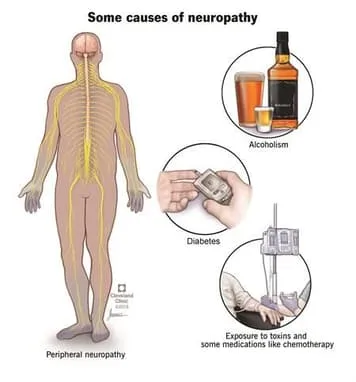WHAT IS NEUROPATHY?
Neuropathy is a general term meaning “nerve problem”. There are two main types of neuropathy, and a variety of causes. The first type of neuropathy we will discuss has been the most common type for years but that is starting to change.
The first type is Large Fiber Mono-Neuropathy (Large Fiber means the bigger nerve bundles closer to the spine and Mono-meaning “one”). Large Fiber Mono-Neuropathy usually begins at the spine level, either the lower neck or lower back, and typically radiates down one arm or one leg.
PERIPHERAL NEUROPATHY
The second type of neuropathy is Small Fiber, Polyneuropathy. (Small Fiber meaning the smaller nerve bundles closer to the ends of the extremities and Poly – meaning “many” because there are many more nerves and nerve endings in these regions than there are closer to the spine).
The first type is Large Fiber Mono-Neuropathy (Large Fiber means the bigger nerve bundles closer to the spine and Mono-meaning “one”). Large Fiber Mono-Neuropathy usually begins at the spine level, either the lower neck or lower back, and typically radiates down one arm or one leg.
This type is quickly becoming more and more prevalent, and estimates are that it affects nearly 46.5 million Americans. This type of neuropathy is also known as Peripheral Neuropathy because it affects the nerves furthest away from the center of the body (like the lower arms, hands, fingers, lower legs, feet, and toes).
The pain of peripheral neuropathy varies from person to person. Some people have a burning type of pain. For some, it feels like electrical shocks. For others, it’s like their feet are being torn apart.
Peripheral Neuropathy is a disorder of the peripheral nerves, which are the nerves that go down into your arms, hands, legs, and feet.
The peripheral nerves are anything outside of the central nervous system, which is just the brain and spinal cord. So, the peripheral nerves like the ones that go down to your hands and feet are the ones that are typically affected in neuropathy.
If you look at the photo below, you’ll see 3 different types of nerves. On the top, there’s a healthy nerve and it has little blood vessels all wrapped around it underneath these blood vessels you have what’s called the myelin sheath. It’s like insulation on an electrical cord and your nerves need it to function properly. In order for that myelin sheath to survive it has to be nourished by blood vessels like the ones you see. When looking at the middle nerve in the picture, it looks like it’s starting to shrink. The constriction of blood vessels in this nerve decreases the amount of blood flow getting to the nerve and it limits the number of nutrients that receives; eventually if this keeps happening it ends up looking like the bottom nerve for it looks like it’s dying off. This is exactly what happens in neuropathy.
CAUSES OF NEUROPATHY
Estimates put the number of causes for Peripheral neuropathy at over 1000! Despite this number, there are really only three main categories of causes.
PHYSIOLOGICAL/FUNCTIONAL CAUSES
Physiological or functional causes of neuropathy are basically health conditions that develop in the body. While there can be health conditions that develop with seemingly no cause, such as Type 1 Diabetes, these causes are typical “lifestyle diseases” that develop as a result of not giving the body what it needs to function properly, such as sufficient daily exercise or hydration, as well as overindulgence in things like food and/or alcohol. Most of these causes involve damage to the cardiovascular/circulatory system and reduced blood flow to the nerves of the lower legs and feet or lower arms and hands. Type 2 Diabetes is the most common lifestyle cause of peripheral neuropathy, however, other circulatory conditions such as heart disease, high blood pressure, congestive heart failure, and stroke can cause peripheral neuropathy as well.
CHEMICAL CAUSES
Chemical causes of peripheral neuropathy include anything that gets into the body by chance or by choice. These include medications like over-the-counter anti-inflammatories as well as statin drugs commonly used for treating high cholesterol, chemotherapy, radiation treatment, Agent Orange, prolonged and heavy alcohol and/or tobacco use, and finally, sugar. Excessive sugar consumption over time can lead to Type 2 Diabetes which is one of the most common causes of Peripheral Neuropathy.
PHYSICAL/TRAUMATIC CAUSES
Physical or traumatic causes of neuropathy typically cause the large fiber mono-neuropathies, like sciatica, although they can contribute to the peripheral type as well as being a sole cause of peripheral neuropathy. Before continuing, let’s talk about age. Neuropathy is not solely an age-related issue, because if it was then every person would develop it and would develop it at the same time, say, at 1:04 pm at the age of 59 1/2 years of age.
Neuropathy can affect people of all ages depending on the cause. We’ve treated patients as young as 19 years and our oldest was 94 when she developed neuropathy. If we break down what “age” really is, it is a number of accumulated days. So, someone who is 10 years old, has lived 3650 days. These days include our normal daily activities like sitting, standing, bending, twisting, lifting, reaching, walking, running, and sleeping just to name a few. These days add up and over time, if we don’t take proper preventative maintenance steps, can create neuropathies.
Now, take these normal daily stresses and throw in some slips, falls, accidents, and injuries along the way. It’s estimated that the average 5-year-old, has fallen down 5000 times! If this happened to us over the next 5 years, we would be bedridden if not worse!
Typically it’s all the things we did as kids or young adults when we thought we were invincible, that catch up to us when we’re older.
This accumulation of stresses over time leads to degenerative conditions like Arthritis, Degenerative Disc or Joint Disease, and Spinal Stenosis which then can increase pressure on or irritate nerves and blood vessels and create these neuropathy problems.
HOW IT WORKS
Imagine for a minute that you have a plant, and you see that your plant is wilting. What might you do to get the plant healthy again? Well, maybe you might think it needs something such as water, maybe more sunshine, or maybe even some nutrients like fertilizer. These are things to think about when we see a wilting plant. If adding things doesn’t work well maybe the plant has bugs on it or maybe it’s planted in some bad or toxic soil that might be causing it to be unhealthy.
The same principles apply to your body and your health, especially when it comes to neuropathy. We have to give your body everything it needs in order to work properly. We are living organisms just like a plant and we have certain requirements that we need and if we don’t get them then we start to have dysfunction and eventually dis-ease. If the nerves in your arms, hands, fingers, legs, feet, or toes are not getting nutrients and growth factors from the blood then just like a plant without water to the roots, the nerves will begin to die, and this then leads to the main type of peripheral neuropathy.
If a plant is wilting what would you do? Well, you give it water, sunlight, and nutrients…that’s exactly what we’re trying to do with your nerves. We’re trying to get new blood vessels and more blood to nourish the nerve back to health.
Let’s dig into what that means. Neuropathy is a condition that requires a multi-pronged approach to treat the affected areas. We found that a nine-part therapy regimen that we’ve developed really works for treating neuropathy and each part is just as important as the others.
We found that we really need to take a comprehensive approach to treating neuropathy. It can’t be done with just simply a medication or an injection because there are so many factors that contribute to peripheral neuropathy. We take a holistic approach to treating it.
Some of the things that we do to treat neuropathy include light therapy which stimulates angiogenesis (new blood vessel formation), electrotherapy which is going to repair, rebuild, regenerate and reeducate the nerves, our metabolic management programs for blood sugar monitoring and also working on your balance, and tending to joint, nerve and muscle health in a variety of other natural ways.
All of these elements come together in our comprehensive neuropathy treatment program. When we evaluate patients in our clinic, we put together a tailored program that’s just for them. We determine how many clinic visits they might need and what any at-home care protocols might look like to get them better.
If it helps fix the underlying causes of neuropathy, it’s in our neuropathy treatment program.
We even have a complete do-it-yourself-at-home care program for people who cannot or do not want to drive long distances for care.


